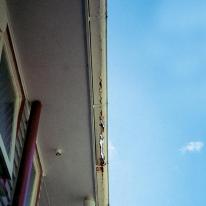Steel eaves gutters – rusting
Cause
There is insufficient fall to drain water
Repair
-
metal eaves gutters should have a minimum fall of 1:500 (2 mm per metre). Where the required fall cannot be provided, PVC gutters that do not rust are a better option
-
where the rusting is relatively light and has not gone right through the steel, remove rust by lightly sanding. Apply a zinc-rich/corrosion-inhibiting primer, then at least two coats of paint designed for use on steel
-
where the rust has gone right through the steel at multiple points, the gutters should be replaced
- when working at height, always let someone know. Ensure the access ladder is in good condition and is securely set up on a solid level base. The correct angle for the ladder is 1 metre out from the wall for every 4 metres of height.
Cause
There are leaves or other debris in the gutter, or weeds growing, retaining moisture and preventing water from draining away
Repair
-
clear away leaves and other debris on a regular basis as frequently as required. Leaf guards may be fitted to keep gutters clear
-
where leaves come from tree branches overhanging the roof or gutter, consider removing the branches
-
ensure the gutters have a minimum fall of 1:500 (2 mm per metre) to prevent water ponding
-
where the rusting is relatively light and has not gone right through the steel, remove rust by lightly sanding. Apply a zinc-rich/corrosion-inhibiting primer, then at least two coats of paint designed for use on steel
-
where the rust has gone right through the steel at multiple points, the gutters should be replaced
- when working at height, always let someone know. Ensure the access ladder is in good condition and is securely set up on a solid level base. The correct angle for the ladder is 1 metre out from the wall for every 4 metres of height.
Cause
Metal debris (swarf and roof offcuts) were left in the bottom of the gutter when the roof was installed
Repair
- clean out the gutters then follow the guidance for the repair above
Cause
There are incompatible metals together, resulting in corrosion – for example, copper guttering with galvanised steel inserts
Repair
-
galvanic corrosion can occur when two incompatible materials are in direct contact with each other in the presence of moisture, or water runs from one onto another
-
one of the materials should be replaced with a material compatible to the other. For example, if copper guttering is fixed with galvanized steel brackets, replace the steel brackets with brackets made of brass
-
ensure the gutters have a minimum fall of 1:500 (2 mm per metre) to allow water to drain and evaporate quickly (all metal corrosion, including galvanic corrosion, requires the presence of moisture)
-
repair or replace the rusted guttering as described above
Cause
There is water flowing from copper (vent pipe or downpipe) onto galvanised or zinc/aluminium or aluminium/zinc alloy steel
Repair
- the previous repair could be followed, with one other option possible – one of the surfaces could be coated. Properly-applied and maintained coatings provide a separation that prevents or reduces the risk of galvanic corrosion occurring
- when working at height, always let someone know. Ensure the access ladder is in good condition and is securely set up on a solid level base. The correct angle for the ladder is 1 metre out from the wall for every 4 metres of height.






